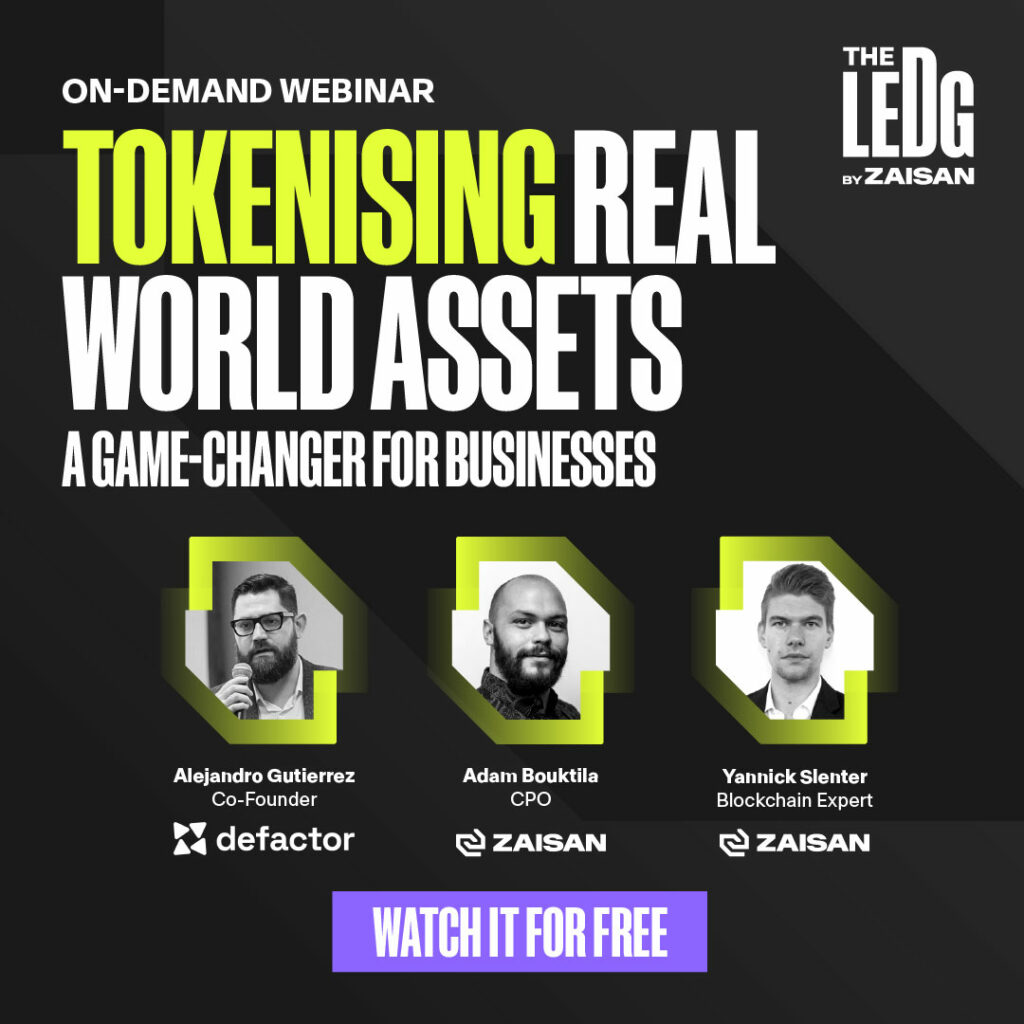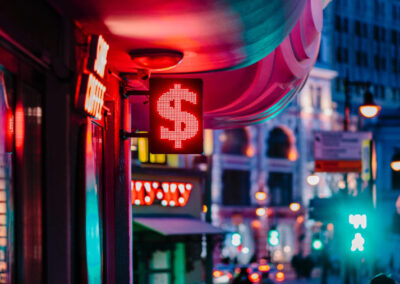Tokenisation is one of the latest web3 trends to emerge. It has taken the world by storm through its relatively simple, yet practical use cases in a wide range of industries. In this article, we will explain what it means to tokenise real world assets, the key aspects of tokenising real world assets, the process of tokenising a real world asset, and the benefits and disadvantages of tokenising real world assets.
Key takeaways
- The tokenisation of real world assets is the process of creating a (fractionalised) digital twin of a physical asset that can be held, bought, and traded on a blockchain.
- The tokenisation process consists of 3 steps, namely the pre-tokenisation step, which refers to all the steps that happen in the real, non-digital, world before the asset is tokenised and put on a chain. The tokenisation step refers to putting all relevant data and data pointers on a blockchain and creating the tokens. And lastly, the post-tokenisation step refers to the distribution of tokens and the management of the physical asset and tokens.
- There are 5 key aspects of tokenisation that need to be considered during the process of tokenising and securitising real world assets: technology, secondary markets & liquidity, legal & compliance, custody & settlements, and dispute resolution.
- The benefits of tokenising real world assets are the fractionalisation of assets, greater liquidity, increased transparency, and lower transaction costs.
- The disadvantages and possible risks of tokenising real world assets are the fragmentation of ownership, regulatory uncertainty, technical complexity, and counterparty risk.
- The future of tokenisation is uncertain as there are many challenges ahead before tokenisation can become mainstream. However, with the right people leading the way, tokenisation can become the future of asset management given its great potential.
Note: this article is also available as an eBook in PDF format, so you can download, read, and share it at your convenience.
Let’s start with what the tokenisation of real world assets actually means!
What is the tokenisation of real world assets?
The tokenisation of real world assets refers to the process of creating a (fractionalised) digital twin of a real world asset that can be traded on a blockchain network. The tokenisation process comes with a variety of benefits. Such as the ability to exchange and own the asset more securely and transparently. But also things like the provenance of the asset, as well as proofs of labour, and more.
The process of tokenisation allows an asset to be divided into smaller parts, making them available to a wider range of investors. Additionally, these assets can easily be traded on global marketplaces, further increasing their availability to a wide range of investors.
Real world asset tokenisation is not limited to certain types of asset classes either. Instead, tokenisation has the potential to benefit a diverse range of asset classes such as tangible assets like real estate, art, precious metals, and luxury goods, as well as intangible assets such as financial instruments, invoices, and carbon credits.
Fractional ownership of properties, for instance, is possible through the tokenisation of real estate, allowing investors to buy and sell small percentages of high-value properties. Similarly, the tokenisation of art can make art investments more accessible to a broader range of investors by allowing them to buy and sell fractions of high-value pieces.
Lastly, tokenisation can potentially solve some of the challenges linked with traditional ownership structures. Tokenisation enables more transparent and efficient ownership structures that can reduce expenses, fraud, and disputes. Smart contracts can also automate many of the processes associated with asset ownership, including transfers, payments, and maintenance.
How the tokenisation of real world assets works
Now it’s clear what the tokenisation of real world assets means. Let’s take a look at what the process of tokenising a real world asset looks like. In short, the process can be described in 3 main steps, namely the pre-tokenisation, tokenisation, and post-tokenisation steps. Let’s explain this further!
Pre-tokenisation
Pre-tokenisation refers to all the steps that occur in the real, non-digital, world before the asset is tokenised and put on a chain. The main parts of this step depend on the type of asset that is being tokenised. It can generally be divided into formalising the value of the asset, verifying ownership of the asset, and ensuring the right processes are in place to take care of the maintenance and management of the physical asset. This includes legal processes in case of liquidations, dispute resolutions, and enforcement.
Tokenisation
Once the pre-tokenisation step has been completed. It is time to make a digital representation of the asset in the form of tokens. The main part of this step is making sure all relevant information about the asset is either put on a blockchain or pointed to from the blockchain and then creating the tokens of the real world asset.
The connection between relevant data in traditional databases and data on the blockchain is facilitated through the use of (decentralised) oracles to ensure all relevant information is accurately represented on the blockchain. These oracles collect data from traditional databases and broadcast it to the blockchain. Furthermore, decentralised oracles do the same but do this collectively to reach a consensus on the accuracy and validity of the data being broadcasted to the blockchain.
Post-tokenisation
After the previous steps have been completed and the tokenised asset has been created, it’s time to start distributing/selling the tokenised assets. This is typically done through marketplaces or offerings specialised in these kinds of assets. Part of this step is also the perpetual management of both the physical asset and the tokens based on the rules previously set. For something like an art piece, this could include the storage of the piece, maintenance of the piece, insurance of the piece, etc., as well as the management of the tokens, including the management of the information about the token.

Key aspects of the tokenisation of real world assets
During the tokenisation process, the value chain with its stakeholders remains central. Here are 5 key aspects of tokenisation that need to be considered during the process of tokenising and securitising real world assets. All of which play a role in the success of the whole process. They can be summarised as follows:
- Technology
- Secondary markets & Liquidity
- Legal & Compliance
- Custody & Settlement
- Dispute resolution
Let’s take a look at each of these aspects!
1. Technology
One of the first and foremost aspects of the tokenisation process is the technology aspect. This refers to all the technical questions such as which blockchain will be used, what data standards will be used, whether the tokens will be fungible or non-fungible, and more.
The type of blockchain that is best suited for tokenising an asset usually depends on the goals one has when tokenising an asset. Different blockchains have different data standards suited for specific purposes and different marketplaces which facilitate the trading of tokens of real world assets. Additionally, the costs of deploying a tokenised asset on a certain blockchain are highly important. Another key component is smart contract support and the preferred programming language of the smart contracts. And lastly, specific communities on a blockchain can also influence the success of a tokenised asset in a certain ecosystem.
All of these considerations combined, along with the decision to go for a certain data standard which determines whether you will end up with a fungible or non-fungible token, can be a key determining factor of the success of the tokenised asset.
2. Secondary markets & Liquidity
The second aspect to consider during the tokenisation process is the availability of secondary markets and liquidity. This is usually closely related to the choice of blockchain, as most marketplaces tend to support tokens or assets from a single blockchain. Although, this is likely to change with a multi-chain future around the corner.
Nevertheless, the availability of trusted and proven marketplaces and a community to facilitate the liquidity of the tokens is essential for the success of a tokenised asset.
3. Legal & Compliance
The third aspect to consider in the tokenisation process is the regulatory and legal side, which is relevant at all stages of the process, especially for assets that are deemed to be securities or require other regulatory oversight.
The first part of this is regulatory compliance. Tokenising physical assets usually involves regulatory requirements depending on the jurisdiction in which the asset is located. For example, in the United States, securities laws may apply if the tokens represent ownership within the asset and are sold to investors. Compliance with anti-money laundering (AML) and know-your-customer (KYC) regulations are usually also required either when selling the tokens or when registering on a token marketplace.
The process of issuing tokens should also be carried out in compliance with applicable laws and regulations. This includes ensuring that the tokens are not being sold as unregistered securities. And lastly, there may be tax implications when tokenising a real world asset.
4. Custody & Settlements
The fourth aspect to consider in the tokenisation process is the existence of any custody and settlement requirements. The tokenisation process creates a digital twin of the asset. However, for the asset to be properly tokenised, various things ought to be considered. For example, it should be ensured that the ownership of the real world asset is actually in the hands of the token holders. Furthermore, the party that tokenises the real world asset holds the deeds and titles to prove the ownership of the asset at the time of tokenisation.
But this is of course not the only relevant point related to this aspect of the tokenisation process. Other things like the management of the physical asset need to be carefully outlined. This refers to things like loans that need to be repaid before an asset can be released, measurements to prevent (and insure against) things like theft, loss, or damage that also need to be agreed upon and be put in place, or arrangements regarding the movement, renovation, etc. of an asset.
These aforementioned considerations mostly refer to the management of the physical asset. But there are also various considerations for the tokens depending on the jurisdiction. There may be restrictions on the transfer of tokens representing ownership of physical assets. For example, in some cases, the transfer of ownership may require the involvement of a licensed broker or agent.
5. Dispute resolution
The fifth and final aspect of the tokenisation process is dispute resolution. Even with all arrangements and precautions in place, there will always be times when there are misunderstandings and disputes. So how does this work with tokenised real world assets?
When it comes to dispute resolution in the context of tokenised physical assets, the process can vary. This depends on the specific platform or protocol being used to facilitate the tokenisation. In most cases, the smart contract of the tokenised asset outlines the exact rules and agreements related to the token (and real world asset), as well as the process for dispute resolution.
However, another approach is to rely on established legal systems and frameworks to resolve disputes. For example, if a dispute arises between parties involved in a tokenised real estate transaction, traditional real estate laws, and courts could be used to resolve the dispute.
Nevertheless, it’s worth noting that the tokenisation of physical assets is a relatively new technology. There may be some legal grey areas and uncertainties when it comes to dispute resolution. As a result, parties involved in tokenised physical asset transactions need to seek legal advice and carefully consider the terms and conditions of any smart contracts or agreements before entering into a transaction.
Benefits of tokenisation of real world assets
But what exactly are the benefits of tokenising real world assets? Some of these advantages can be summarised as follows:
- Fractionalisation
- Greater liquidity
- Increased transparency
- Lower transaction costs
1. Fractionalisation
Tokenisation allows assets to be divided into smaller portions which means that investors can buy and sell fractions of an asset, rather than having to buy the whole asset. For example, instead of buying an entire real estate property, investors can purchase a percentage of ownership in the property. This opens up investment opportunities to a wider range of investors, including those who may not have enough capital to buy an entire asset.
Another benefit of fractionalisation is that it allows for more flexible ownership structures which can be better tailored to the investors, in turn increasing the appeal of the investment.
Lastly, the fractionalisation of assets can also be beneficial for community building, in the case of valuable art for example. Instead of having a single owner, it becomes a community-owned asset which can increase both the appeal and value of a physical asset. Who wouldn’t want to own part of the Mona Lisa?
2. Greater liquidity
Tokenisation makes assets more accessible and tradable on a blockchain, which can increase liquidity. In traditional markets, it can be difficult to find buyers and sellers for certain assets. However, by tokenising an asset and trading it on a blockchain, investors can quickly and easily buy and sell the tokens without needing to go through intermediaries. This can increase the speed and efficiency of transactions, making it easier for investors to enter and exit the market. And unlike traditional asset purchases transactions are instantaneous and seamless.
Furthermore, given that the asset is split up into smaller portions (represented by tokens) the asset becomes an investment opportunity to a wider range of investors, increasing liquidity even further.
It is important to note though that this is not the case for every type of asset, depending on the jurisdiction in which the physical asset resides. Token transactions may still be subject to rules and regulations which can make the buying or transfer process equally inefficient as the regular process, and possibly even more cumbersome in some cases.
3. Increased transparency
Tokenisation can make it easier to track ownership and movement of assets, as all transactions are recorded on a blockchain. This increases transparency and reduces the risk of fraudulent activity, as ownership of the asset is easily verifiable. Additionally, since all transactions are recorded on the blockchain, it is easier to audit the history of the asset (and tokens). Thus, this can be important for compliance and regulatory purposes.
This can also be beneficial for tracking the provenance of certain assets, as the digital twin can contain the full history of the physical asset.
4. Lower transaction costs
Generally speaking, tokenisation can reduce the costs associated with buying, selling, and managing assets. By removing the need for intermediaries like brokers and custodians, tokenisation can significantly reduce transaction fees. Additionally, tokenisation has the potential to make it easier to manage assets. All ownership and transaction data is stored on the blockchain, reducing administrative and legal costs associated with traditional asset management.
It is important to mention however that the tokenisation process can also increase costs if the stakeholders want greater trust and transparency before, during, and after the tokenisation process.
Disadvantages of tokenisation of real world assets
As with any novel technology, there are never only advantages. Some of the disadvantages and possible risks of tokenising real world assets can be summed up as follows:
- Fragmentation
- Regulatory uncertainty
- Technical complexity
- Counterparty risk
1. Fragmentation
While fractionalisation can be seen as a benefit, it can also lead to the fragmentation of ownership. The more diversified the ownership of an asset becomes, the more difficult it will be to reach consensus on decisions related to the asset which can lead to conflicts between token holders, which consecutively could impact the value of the asset.
2. Regulatory uncertainty
As the use of tokenisation is relatively nascent, there is still regulatory uncertainty surrounding it. This can create challenges for both investors and issuers alike, as they may be unsure about how to comply with regulations, and which regulations apply to tokenisation exactly.
Furthermore, new regulations surrounding tokenisation could also pose new threats and hurdles to the overall tokenisation process.
3. Technical complexity
Tokenisation requires technical knowledge to implement. It can prove to be a barrier for everyday asset owners looking to tokenise their assets. But, a steep learning curve is not the only possible barrier. A lack of understanding of all the aspects of the technological side can lead to poorly designed and written smart contracts. In turn, this opens the door to hackers and cyberattacks.
Furthermore, given the technical complexity of using this kind of technology token holders of lower technical proficiency may be more susceptible to falling for new forms of scams and hacks.
4. Counterparty risk
While tokenisation can reduce the need for intermediaries, it can also create new forms of counterparty risk. And if the tokens are held on that marketplace or exchange, you do not control the funds yourself. If these exchanges go bankrupt or hacked, it can become difficult to recover the investments from that marketplace or exchange.
While this can of course be mitigated by taking the tokens out of the platform, history has shown that many people still prefer the convenience of keeping their tokens on an exchange, despite the possible risks. Furthermore, if organisations want to manage their tokenised assets themselves they might require specific roles and functions to manage the relevant wallets which hold the tokens.
Fractional ownership: the future?
The tokenisation of real world assets has clear benefits and opens up many new opportunities. However, on the flip side, there are also many challenges ahead. As with any nascent technology, it remains to be seen whether tokenisation will become the norm for ownership of various types of real world assets or just a small technological sidestep with little impact.
For tokenisation to become the norm, pioneers will need to pave the way for others. There will need to be major developments in terms of technology, marketplaces, regulations, and more before tokenisation can become mainstream. Nonetheless, with the clear benefits in mind and the constantly growing interest in web3 technologies, the future seems bright for tokenisation.
To help companies navigate through the tokenisation process, Zaisan offers end-to-end tokenisation services. Zaisan allows you to focus on the things you do best, while Zaisan takes care of the rest.




